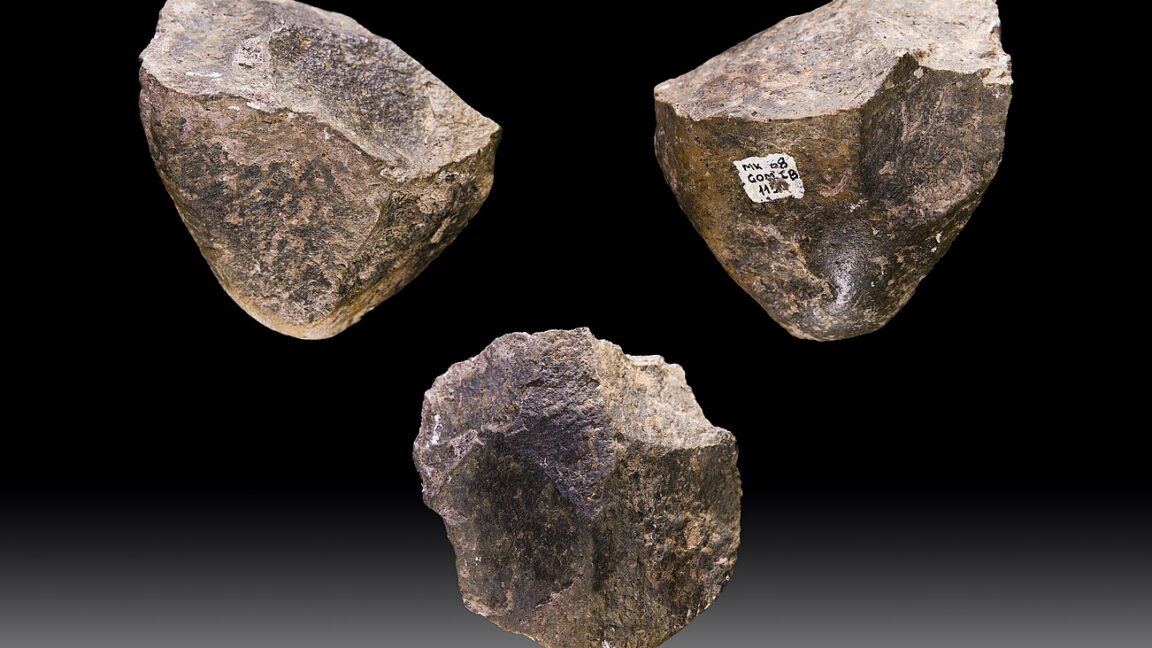Science
Archaeologists Discover 2.75 Million-Year-Old Stone Tools in Kenya

Recent archaeological discoveries at the site of Nomorotukunan in Kenya have revealed layers of stone tools that span an impressive timeline of approximately 300,000 years. These artifacts, dating back to 2.75 million years ago, showcase the enduring reliance of ancient hominins on the same stone tool technology while adapting to significant environmental changes.
The excavation, led by a team from George Washington University, uncovered some of the oldest examples of Oldowan tools, the earliest known sharp-edged stone implements created by hominins. Only three other sites in Africa have yielded tools older than 2.6 million years. These hand-sized rocks, meticulously chipped to create sharp edges, represent a technological milestone from the period between 2.9 million years ago and 1.7 million years ago.
Uncovering Layers of History
The discovery at Nomorotukunan is particularly notable due to the site’s rich stratigraphy. The multiple layers of sediment, interspersed with volcanic tuff, provide a rare glimpse into the continuity of tool-making practices over thousands of generations. David Braun, an archaeologist involved in the study, remarked, “This site reveals an extraordinary story of cultural continuity.”
The sediment layers indicate that members of various ancient hominin species may have passed down their knowledge of tool-making techniques through approximately 10,000 generations. This remarkable timeline highlights the stability of Oldowan technology amidst changing climates, where hominins faced challenges such as droughts and shifting vegetation.
The transition from the Pliocene to the Pleistocene epoch marked a significant climatic shift. Evidence from the site suggests that the once-abundant lakeshore marshes gradually gave way to arid grasslands. Rahab N. Kinyanjui, an archaeologist from the National University of Kenya, noted, “As vegetation shifted, the toolmaking remained steady. This is resilience.”
The Role of Tools in Survival
The stone tools were likely crucial in helping hominins adapt to their changing environment. In the warmer, more humid Pliocene, food sources were plentiful. However, as conditions became harsher, early hominins would have needed to employ their tools for scavenging and digging. Cut marks found on animal bones at the site indicate that these early humans were capable of processing carcasses for sustenance.
While sharpened wood sticks may also have been employed, the archaeological record typically favors more durable materials like stone, allowing researchers to focus on the stone tools and cut bones as key indicators of early hominin behavior. Dan Rolier, a coauthor of the study from Utrecht University, emphasized that these findings reflect “one of our oldest habits: using technology to steady ourselves against change.”
The discoveries at Nomorotukunan may also suggest an even earlier origin for Oldowan technology than previously believed. The oldest tools from this site indicate a sophisticated understanding of flint-knapping, where early hominins knew precisely how to strike stone at specific angles to achieve the desired shapes.
Niguss Baraki, another coauthor from George Washington University, stated, “These finds show that by about 2.75 million years ago, hominins were already good at making sharp stone tools, hinting that the start of the Oldowan technology is older than we thought.”
As archaeological efforts continue, researchers hope to uncover more sites like Nomorotukunan that could illuminate the early relationship between hominins and their tools. The findings also raise intriguing questions about the evolution of technology among our primate ancestors.
In summary, the excavation at Nomorotukunan offers compelling evidence of a long-standing tradition of tool use among early hominins, highlighting their remarkable adaptability in the face of environmental changes. As researchers delve deeper into the past, these discoveries enrich our understanding of human evolution and the role of technology in survival.
-

 Science3 months ago
Science3 months agoToyoake City Proposes Daily Two-Hour Smartphone Use Limit
-

 Health3 months ago
Health3 months agoB.C. Review Reveals Urgent Need for Rare-Disease Drug Reforms
-

 Top Stories3 months ago
Top Stories3 months agoPedestrian Fatally Injured in Esquimalt Collision on August 14
-

 Technology3 months ago
Technology3 months agoDark Adventure Game “Bye Sweet Carole” Set for October Release
-

 World3 months ago
World3 months agoJimmy Lai’s Defense Challenges Charges Under National Security Law
-

 Lifestyle3 months ago
Lifestyle3 months agoVictoria’s Pop-Up Shop Shines Light on B.C.’s Wolf Cull
-

 Technology3 months ago
Technology3 months agoKonami Revives Iconic Metal Gear Solid Delta Ahead of Release
-

 Technology3 months ago
Technology3 months agoApple Expands Self-Service Repair Program to Canada
-

 Technology3 months ago
Technology3 months agoSnapmaker U1 Color 3D Printer Redefines Speed and Sustainability
-

 Technology3 months ago
Technology3 months agoAION Folding Knife: Redefining EDC Design with Premium Materials
-

 Technology3 months ago
Technology3 months agoSolve Today’s Wordle Challenge: Hints and Answer for August 19
-

 Business3 months ago
Business3 months agoGordon Murray Automotive Unveils S1 LM and Le Mans GTR at Monterey









